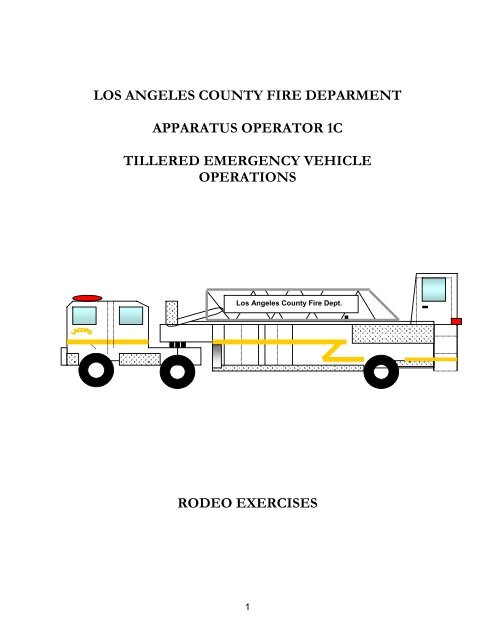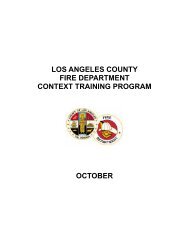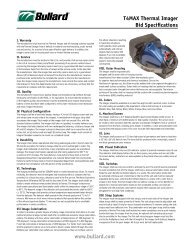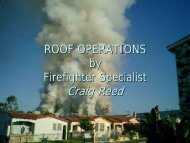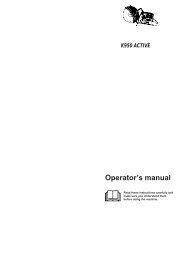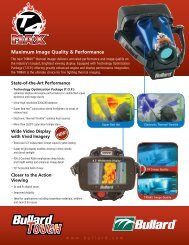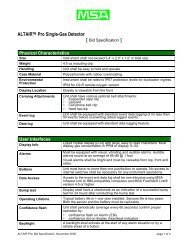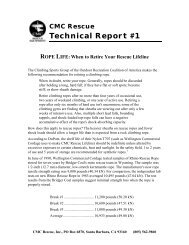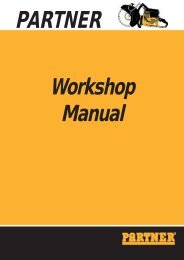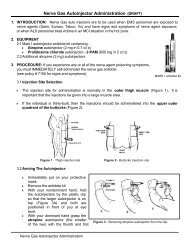Truck Rodeo Manual - Los Angeles County Firefighters Association
Truck Rodeo Manual - Los Angeles County Firefighters Association
Truck Rodeo Manual - Los Angeles County Firefighters Association
You also want an ePaper? Increase the reach of your titles
YUMPU automatically turns print PDFs into web optimized ePapers that Google loves.
LOS ANGELES COUNTY FIRE DEPARMENT<br />
APPARATUS OPERATOR 1C<br />
TILLERED EMERGENCY VEHICLE<br />
OPERATIONS<br />
<strong>Los</strong> <strong>Angeles</strong> <strong>County</strong> Fire Dept.<br />
RODEO EXERCISES<br />
1
FORWARD STOP / STRAIGHT LINE BACKING<br />
The driver and tiller operator will drive forward between two rows of markers.<br />
They must maneuver the apparatus through this lane without touching the<br />
markers and stop the apparatus within 6 inches of the cones. At the signal of the<br />
proctor, the driver and tiller operator will back the apparatus out of the lane in a<br />
straight line without touching the markers.<br />
100’ 100’<br />
10'<br />
Stop within 6”<br />
Constant Speed Zone<br />
Forward<br />
Reverse<br />
2
DIMINISHING CLEARANCE DRIVING EXERCISE<br />
This exercise teaches the driver depth perception and handling<br />
characteristics of fire department apparatus. It reinforces the employee’s<br />
mental and physical reactions required to avoid accidents, which will result<br />
in the prevention of apparatus damage and possible injury or death.<br />
The diminishing clearance exercise measures a driver’s ability to steer the<br />
apparatus in a diminishing straight line, and to judge distances from wheel to<br />
object. The course for this exercise is arranged by two rows of markers that form<br />
a lane at least 100 feet long. The lane narrows from a width of two (2) feet wider<br />
than the vehicle to a diminishing clearance of four (4) inches. The driver must<br />
maneuver the apparatus through this lane without touching the cones.<br />
100’ 100’<br />
9'3"<br />
10'<br />
Forward<br />
Reverse<br />
This evolution is arranged with two rows of markers that form a lane 160 feet<br />
long. The lane narrows from a width of 10 feet to a diminishing clearance of 9<br />
feet 3 inches. The driver and tiller operator must maneuver the apparatus<br />
through this lane without touching the markers. The driver must stop the<br />
apparatus within 6 inches of the finish line. At the signal of the proctor, the<br />
driver and tiller operator will back the apparatus out of the lane without<br />
touching the markers. If the driver hits the front bumper into the finish line, the<br />
event is failed.<br />
3
OFFSET ALLEY DRIVING EXERCISE<br />
This exercise teaches the driver depth perception and the handling<br />
characteristics of fire department apparatus. It reinforces the employee’s mental<br />
and physical reactions required to avoid accidents, which will result in the<br />
prevention of apparatus damage and possible injury or death.<br />
The offset alley driving exercise is designed to test the driver’s capabilities of<br />
quickly changing lane positions which may occur due to changing traffic<br />
conditions. The course is composed of two turns, where the barriers are set at<br />
close tolerances to the apparatus. The course is set up to compensate for vehicle<br />
width and length. Distance between the two jogs shall be equal to the vehicle<br />
length. Width of the driving lanes is 12 feet.<br />
65’ 60’ 40’<br />
12’<br />
24’<br />
12’<br />
Forward<br />
Reverse<br />
The driver shall first drive forward through the course, then will drive backwards<br />
through the course. There is no set speed established for this maneuver, but should be<br />
driven in a constant, deliberate manner.<br />
First, the driver and tiller operator will maneuver the apparatus forward through the<br />
lanes in one continuous motion without touching any markers and stop after the<br />
apparatus has cleared the alley. At the signal of the proctor, the driver and tiller<br />
operator will back the apparatus through the lanes in one continuous motion without<br />
touching any markers and stop after the apparatus has cleared the alley.<br />
PARALLEL PARKING<br />
4
66’<br />
1<br />
12’<br />
18" maximum<br />
Forward<br />
Reverse Forward<br />
The driver and tiller operator will drive forward into the parking space using the<br />
"crabbing" technique and stop the apparatus at the forward cones of the marked<br />
parking space. They will back the apparatus in one continuous motion to align<br />
the apparatus along the curb line. The apparatus should be within 18" of the<br />
curb when parked. Hitting course markers to the front or rear is an event failure.<br />
MEASURED RIGHT & LEFT TURN<br />
5
20'<br />
20’<br />
24"<br />
20'<br />
The driver and tiller operator will drive forward through a 20' wide lane. At the<br />
end of the lane, they will make a right or left turn, depending on the evolution,<br />
into a lane 20' wide. The rear wheel of the tractor and the wheel of the tiller must<br />
be within 24 inches of the cone located at the inside corner of the turn. The driver<br />
and tiller operator must maneuver the apparatus through the lanes without<br />
stopping or touching the markers. Touching the inside corner marker is an event<br />
failure.<br />
STALL PARKING/STATION APPARATUS BACKING DRIVING<br />
EXERCISE<br />
The alley dock driving exercise tests the driver’s ability to move a vehicle<br />
backwards from a non-restricted area, into a restricted area such as an alley,<br />
dock or fire Station. This exercise demonstrates the difficulties involved in<br />
backing the vehicle without striking walls or boundaries, and to bring the vehicle<br />
6
to a stop close to the rear wall.<br />
The boundary lines developed for this exercise are to simulate driving forward on<br />
a street, stopping and backing into a driveway or alley. The street width is to be<br />
a minimum of 40 feet wide, similar to the distance of a four lane street.<br />
Perpendicular to the street is an alley 14 feet wide and the length of the<br />
apparatus deep. The procedure for driving the exercise is to drive past the alley,<br />
stop and then back the vehicle into the alley, stopping before the rear boundary<br />
line. Back up guides shall be used during the exercise.<br />
40 ‘<br />
14'<br />
55’<br />
Stop apparatus at 10' set back<br />
TURN-AROUND DRIVING EXERCISE<br />
F<br />
I<br />
N<br />
I<br />
S<br />
H 40’<br />
S<br />
T<br />
A<br />
R<br />
T<br />
7
58’<br />
Forward<br />
Forward<br />
Reverse<br />
14’<br />
14’<br />
The driver and tiller operator will drive forward and stop just pass the intersection.<br />
Then back the apparatus into the right lane of the intersecting lane. Proceeding<br />
forward, they will make a left turn and travel in the opposite direction that they<br />
were originally traveling.<br />
8
CUL-DE-SAC DRIVING EXERCISE<br />
Drivers of fire department apparatus are often required to turn around in limited<br />
space either for a change of direction, or to spot at an emergency scene. This<br />
exercise offers the driver an understanding of the limitations of the turning radius<br />
required for apparatus turn-around.<br />
Fire apparatus often needs to be turned around to complete an operation. This<br />
turning around exercise helps to develop a driver’s ability to properly spot<br />
apparatus for operations. Although turning fire apparatus around may not be<br />
difficult in adequate space, it becomes more complicated in narrow streets or<br />
intersections. However, if street width is adequate and if traffic conditions permit,<br />
the U-turn may be used.<br />
12’<br />
12’<br />
12’<br />
14’<br />
24’<br />
76’<br />
or<br />
(2W+L)<br />
of<br />
vehicle<br />
9
SERPENTINE DRIVING EXERCISE<br />
First Circuit :<br />
Second Circuit:<br />
Starting the first circuit, the driver is required to drive the apparatus along<br />
the left side of the markers in a straight line and stop just beyond the No. 1<br />
marker. Then in one continuous motion, the driver and tiller operator must<br />
back the apparatus between the markers. Start by passing to the left of<br />
No. 1, to the right of No. 2, to the left of No. 3, and to the right of No. 4. At<br />
this point, the driver and tiller operator must stop the vehicle just beyond<br />
the last marker. Next, drive the apparatus forward between the markers<br />
by passing to the left of No. 4, to the right of No. 3, to the left of No. 2, and<br />
the right of No. 1.<br />
After completing the first circuit, the driver and tiller operator must complete a<br />
second circuit, which is the opposite as the first circuit. Drive the apparatus along<br />
the right side of the markers in a straight line and stop just beyond the No. 1<br />
marker. Continue the circuit, passing the markers on the opposite side as the first<br />
circuit.<br />
SERPENTINE BACKING & FORWARD EXERCISE<br />
10
56’ 56’<br />
56’<br />
Forward<br />
Forward<br />
Reverse<br />
An area of approximately 40’ x 224’ is required because the Tiller Quint drives<br />
forward and reverse in a serpentine manner around a row of five cones placed<br />
an equal distance apart. The distance between the cones should be the length<br />
of the tractor/trailer.<br />
11


